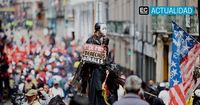Every May 1st, International Workers' Day is commemorated, honoring the historical struggles of workers for better labor conditions. This significant date traces its origins back to the events in Chicago in 1886, known as the Haymarket Riot, which remains a pivotal moment in labor history.
In 1886, workers faced grueling workdays of up to 18 hours in poor conditions. On May 1 of that year, thousands of laborers initiated a strike demanding an eight-hour workday, a movement that sparked massive protests across the United States. The situation escalated on May 4, when a bomb exploded during a demonstration in Haymarket Square, resulting in the deaths of both police officers and civilians. This tragic incident led to a brutal crackdown on labor leaders, who were later executed, earning them the title of the "Martyrs of Chicago." In 1889, the Socialist Workers' Congress of the Second International, held in Paris, officially established May 1st as International Workers' Day to honor these martyrs and advocate for labor rights.
In Mexico, the commemoration of this day began in 1913, during the Mexican Revolution. The first workers' parade was organized by the Casa del Obrero Mundial, attracting over 25,000 participants. This event marked a significant step in the fight for labor rights in the country.
The importance of International Workers' Day in Mexico is underscored by the labor rights enshrined in Article 123 of the 1917 Constitution, which guarantees an eight-hour workday, a dignified wage, social security, and the right to unionize. According to the Federal Labor Law, May 1st is an official holiday in Mexico, meaning that most workers do not have to work. However, essential sectors such as tourism, healthcare, and security may require some employees to work, who are entitled to double pay as compensation.
Meanwhile, in Ecuador, the significance of May 1st has been felt for over a century, marked by local initiatives, resistance, and social struggles. Historian Germán Rodas Chaves notes that the first workers' groups in Ecuador emerged in the last three decades of the 19th century. In the Sierra region, these groups maintained ties with conservative sectors, while in the coastal areas, they leaned towards radical liberalism.
Rodas emphasizes that the events of May 1, 1886, in Chicago, although far removed, had a profound impact on the burgeoning Ecuadorian working class. The repression faced by American workers resonated deeply with the popular sectors in Ecuador. The first commemorative meeting of Labor Day in Ecuador took place in Guayaquil on May 1, 1911, called by Rafael Ramos, president of the Society of Market Suppliers. This gathering was held in a closed venue, lacking public character. Simultaneously, the Committee of May 1 was already active, aligning with international labor initiatives to keep the memory of the Chicago events alive. This committee brought together various artisan, cultural, and labor centers from Guayaquil.
By 1912, the commemoration of May 1st had spread to other cities in the Guayas province, though these meetings remained private. It wasn't until 1913 that activities took on a public character in Guayaquil, Daule, Esmeraldas, Riobamba, and Quito. Rodas notes that by this time, workers' groups from both the Sierra and the Coast had consolidated into organizations advocating for collective rights.
In 1914, some workers from the Port of Guayaquil requested a holiday for Labor Day, but their request was denied. The following year, Carlos Rolando Lobatón, president of the Committee of May 1 and delegate of the Abdón Calderón Cultural Center, pressed the liberal government of Leónidas Plaza for recognition of the holiday. On April 23, 1915, President Plaza signed a decree establishing May 1st as a holiday for Ecuadorian workers.
In 1916, workers convened assemblies in various cities with a clear objective: to demand a law that would set a maximum limit on working hours. That same year, Congress approved the eight-hour workday and overtime pay. However, Rodas points out that these provisions were not fully implemented, leading to further protests.
As the 1st of May approached in 1917, President Alfredo Baquerizo Moreno expressed interest in attending some of the workers' assemblies in Guayaquil. However, Agustín Freire Icaza, a Guayaquil union leader, warned liberal leaders about the potential for the president to use the event for political gain. Ultimately, Baquerizo opted not to participate, allowing workers to gather freely. This gesture recognized that freedom should not be limited to those who support the government but must also be extended to dissenters.
Thus, May 1st solidified its place in Ecuador not just as a day of rest, but as a powerful symbol of organization, memory, and labor struggle. The ongoing observance of this day serves as a reminder of the sacrifices made by workers in the past and the continuing fight for better labor conditions.




